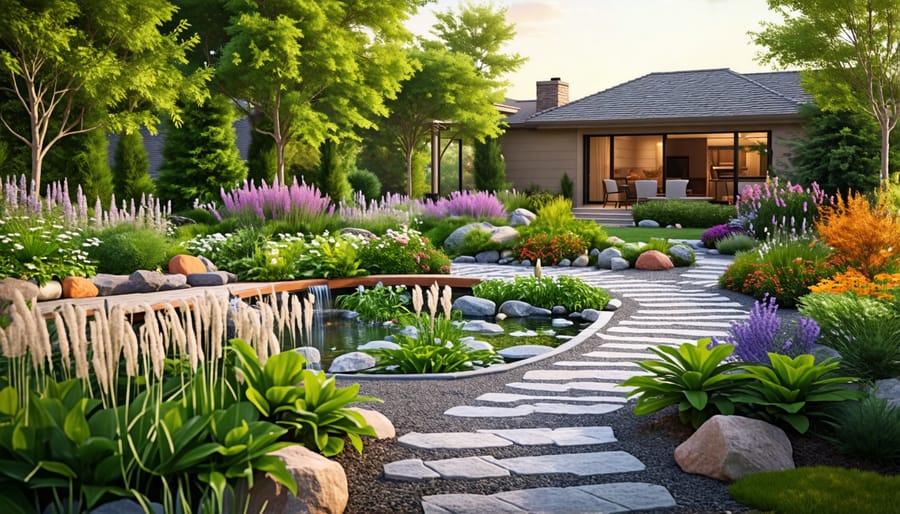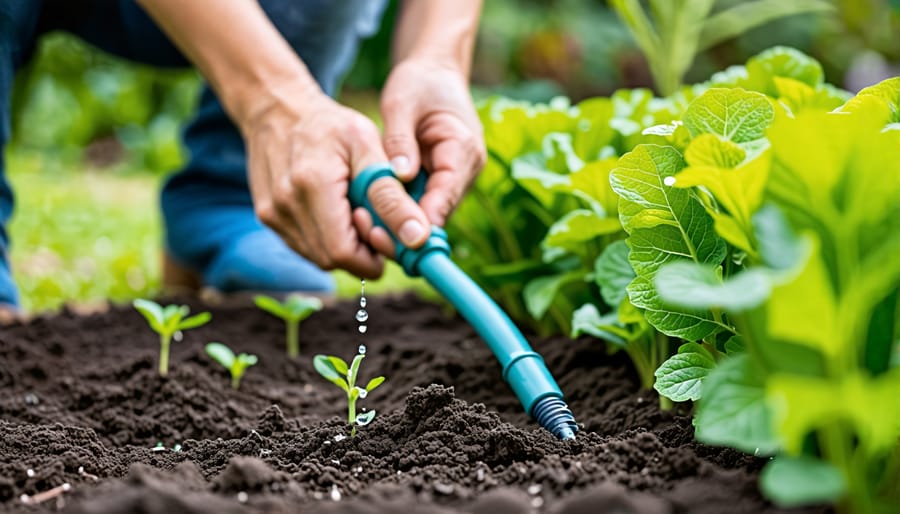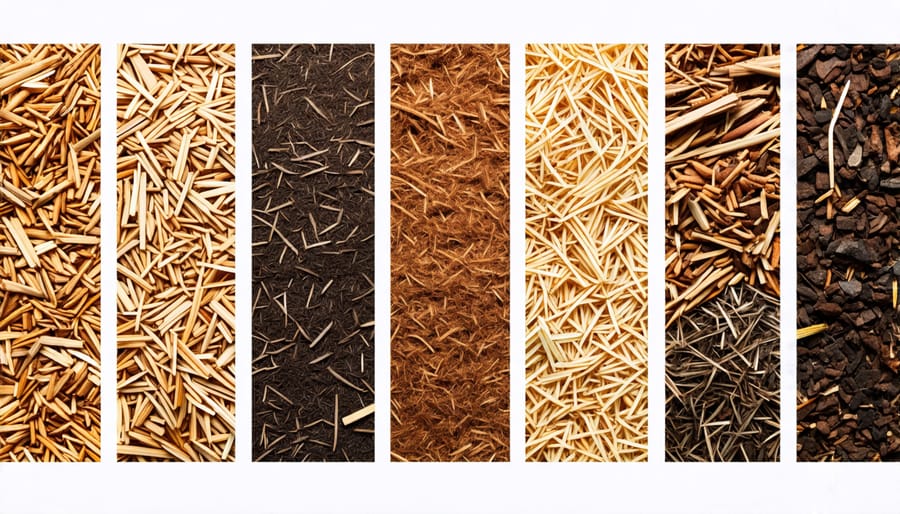Choose native plants that are well-adapted to your local climate and soil conditions to minimize the need for supplemental watering, fertilizing, and pest control. Mulch garden beds with organic materials like wood chips, leaves, or straw to retain soil moisture, suppress weeds, and regulate soil temperature. Eco-friendly landscaping secrets include capturing rainwater in rain barrels or cisterns to use for irrigation during dry spells, reducing your reliance on municipal water sources. Mow your lawn less frequently and at a higher height to encourage deeper roots, improve drought tolerance, and crowd out weeds naturally.
Designing an Eco-Friendly Landscape

Selecting Native and Drought-Tolerant Plants
Selecting the right plants for your eco-smart landscape is crucial for creating a thriving, sustainable outdoor space. By opting for native and drought-tolerant plants, you ensure that your garden is well-adapted to the local climate and soil conditions. These plants have evolved to thrive in your area, requiring less water, fertilizer, and maintenance compared to non-native species.
When choosing native plants, consider factors such as sun exposure, soil type, and moisture levels in your yard. Many native plants have deep root systems that help them access water and nutrients more efficiently, making them more resilient to drought and extreme weather conditions.
Incorporating a diverse mix of native plants not only enhances the beauty of your landscape but also supports local ecosystems by providing food and shelter for beneficial insects, birds, and other wildlife. By working with nature rather than against it, you can create a harmonious and sustainable outdoor environment that benefits both your family and the planet.
Creating Efficient Irrigation Systems
Designing an efficient irrigation system is key to saving water in your eco-smart landscape. Drip irrigation is a highly effective method that delivers water directly to plant roots, minimizing evaporation and runoff. By installing a network of tubes with emitters near each plant, you can precisely control the amount of water delivered. Another smart addition is a rain sensor, which automatically shuts off your irrigation system when it detects sufficient rainfall. This prevents overwatering and conserves resources. When planning your irrigation layout, group plants with similar water needs together to optimize efficiency. Regularly inspect your system for leaks, and adjust watering schedules based on weather conditions and plant requirements. By implementing these water-wise strategies, you’ll create a thriving, eco-friendly landscape that conserves one of our most precious resources.

Incorporating Permeable Surfaces
Incorporating permeable surfaces into your landscape design is a smart way to reduce water runoff and improve drainage. Instead of traditional concrete or asphalt, opt for permeable pavers, which allow water to seep through the gaps and into the soil below. This helps prevent erosion and keeps your garden beds hydrated. Gravel and mulch are also excellent alternatives, as they allow water to percolate through while adding texture and visual interest to your yard. By choosing permeable materials, you not only create a more eco-friendly landscape but also reduce the strain on storm drains and minimize the risk of flooding. Plus, these materials often require less maintenance than solid surfaces, saving you time and effort in the long run. When installing permeable surfaces, be sure to follow proper grading techniques to ensure optimal drainage and prevent standing water.
Maintaining an Eco-Smart Yard

Mulching for Moisture Retention and Weed Control
Mulching is a simple yet effective way to conserve water and suppress weeds in your eco-smart landscape. Begin by selecting an organic mulch, such as shredded bark, wood chips, or pine needles, which will naturally decompose and enrich your soil over time. Apply a layer of mulch around your plants, about 2-3 inches deep, taking care not to pile it against the plant stems or tree trunks, as this can lead to rot and disease.
As you mulch, leave a small gap around the base of each plant to allow for proper air circulation and water penetration. The mulch layer will act as a protective barrier, shielding the soil from direct sunlight and reducing evaporation, thus conserving moisture and minimizing the need for frequent watering. Additionally, mulch will suppress weed growth by blocking light from reaching the soil surface, preventing weed seeds from germinating.
To maintain the effectiveness of your mulch, replenish the layer as needed, typically once or twice a year. As the organic mulch decomposes, it will contribute valuable nutrients to the soil, promoting healthier plant growth and reducing the need for synthetic fertilizers. By implementing proper mulching techniques, you’ll create a more sustainable and low-maintenance landscape that conserves water and naturally controls weeds.
Composting and Natural Fertilizers
Composting is a fantastic way to recycle yard waste and create nutrient-rich soil for your eco-smart landscape. Start by setting up a compost bin or pile in a convenient location, and add a mix of green materials (grass clippings, fresh leaves) and brown materials (dried leaves, twigs). Maintain a good balance of these materials, keep the pile moist, and turn it regularly to promote decomposition. In a few months, you’ll have a supply of “black gold” to nourish your plants.
When it comes to fertilizing, opt for organic options like compost tea, bone meal, or fish emulsion. These natural fertilizers release nutrients slowly, supporting plant health without the risk of chemical runoff. Mulching with organic materials like shredded leaves or bark also helps retain moisture and suppress weeds, reducing the need for frequent watering and herbicides.
By embracing composting and organic fertilizers, you’re not only nurturing a thriving, eco-friendly landscape but also minimizing waste and protecting the environment. Plus, you’ll enjoy the satisfaction of knowing that your vibrant garden is the result of your own sustainable efforts. So, get started on your composting journey today and watch your landscape flourish the eco-smart way!
Integrated Pest Management Strategies
When it comes to managing pests in your eco-smart landscape, there are several natural and effective strategies you can employ. One of the most important is encouraging beneficial insects, such as ladybugs, lacewings, and parasitic wasps, which prey on common garden pests. Planting a diverse array of native flowers and herbs will attract these helpful critters to your yard. Another eco-friendly approach is using physical barriers, like row covers or netting, to protect your plants from insects and other critters without resorting to harmful chemicals.
You can also try companion planting, which involves strategically placing certain plants together to deter pests naturally. For example, planting basil near tomatoes can repel aphids and whiteflies. If pests do become a problem, consider using organic pest control products like neem oil or insecticidal soaps, which are less harmful to the environment than synthetic chemicals. Regularly monitoring your plants for signs of pest activity and removing affected leaves or stems can help prevent infestations from taking hold. By adopting these integrated pest management strategies, you’ll create a thriving, eco-friendly landscape that’s naturally resistant to pests.
Enjoying Your Eco-Smart Landscape
Creating Outdoor Living Areas
Incorporating seating, dining, and relaxation zones into your eco-smart landscape is essential for creating inviting outdoor living areas. Consider using natural materials like sustainable wood, bamboo, or recycled plastic for furniture pieces that blend seamlessly with the environment. Position comfortable seating in shaded areas to enjoy your garden’s tranquility, and create a dedicated dining space for al fresco meals with family and friends. Enhance the ambiance with eco-friendly lighting options such as solar-powered string lights or lanterns. Incorporate cozy elements like outdoor rugs, throw pillows, and blankets made from organic or recycled materials to create a welcoming atmosphere. Don’t forget to include features that encourage relaxation, such as a hammock nestled between trees, a meditation corner with a water feature, or a reading nook surrounded by fragrant plants. By thoughtfully designing these outdoor living areas, you’ll maximize the enjoyment of your eco-smart landscape while minimizing your environmental impact.
Attracting Wildlife and Pollinators
To attract wildlife and pollinators to your eco-smart landscape, choose native plants that provide food, shelter, and nesting sites. Consider adding a diverse mix of flowering plants, shrubs, and trees that bloom at different times throughout the season. Create a welcoming habitat by incorporating features like bird baths, feeders, and insect hotels. Leave some areas of your yard untamed, with fallen leaves and branches, to provide shelter for beneficial creatures. Avoid using pesticides, as they can harm the very wildlife you aim to attract. Instead, let nature’s helpers, like ladybugs and praying mantises, keep pests in check. By creating a haven for wildlife and pollinators, you’ll not only enjoy the beauty and activity they bring to your yard but also contribute to the health of your local ecosystem. Remember, even small changes can make a big difference in supporting the creatures that share our environment.
Conclusion
Embracing eco-smart landscaping is a rewarding journey that benefits both your outdoor space and the environment. By incorporating native plants, implementing water-saving techniques, and adopting sustainable maintenance practices, you can create a thriving, low-impact landscape that supports local ecosystems and conserves resources. Remember, even small changes can make a significant difference in reducing your environmental footprint and creating a more resilient yard.
As you embark on your eco-smart landscaping journey, start by assessing your current landscape and identifying areas for improvement. Gradually introduce native plants, replace water-hungry lawns with drought-tolerant alternatives, and establish efficient irrigation systems. Embrace sustainable practices like composting, mulching, and natural pest control to maintain a healthy, vibrant outdoor space.
The benefits of eco-smart landscaping extend far beyond the environmental impact. You’ll enjoy a beautiful, diverse landscape that attracts beneficial wildlife, requires less maintenance, and saves you time and money in the long run. Plus, you’ll have the satisfaction of knowing that you’re doing your part to protect and preserve our planet for future generations.
So, take that first step towards a more sustainable future and start transforming your outdoor space today. With dedication and creativity, you can create an eco-smart landscape that reflects your values and enhances your quality of life.
